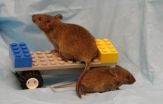(Press-News.org) Researchers at the University of Warwick have discovered a new target for drugs that could prevent the deaths of thousands of women in the developing world due to heavy blood loss after childbirth.
Postpartum haemorrhage (PPH) occurs when the uterus fails to contract vigorously after childbirth and the mother loses 500mls or more of blood in the 24 hours after delivery. PPH is responsible for maternal death in 1 in 1,000 deliveries in the developing world. According to recent figures, PPH also complicates around 10% of all births in England and Wales.
The research team, led by Warwick Medical School, has published their findings in EMBO Molecular Medicine.
They have identified a novel drug target called Kir7.1, which when inhibited induces an acute and sustained uterine contraction that could help treat cases of PPH.
Lead author Dr Andrew Blanks, Associate Professor in Reproductive Health at Warwick Medical School, said: "There are currently no drugs available that are effective at treating PPH. PPH is a major global cause of maternal morbidity and mortality, accounting for around 25% of deaths in postpartum mothers in developing nations. Drugs designed to this target have the potential to be used at low doses to encourage normal contractions in a clinical induction, so avoiding a long labour, which results in uterine fatigue. High doses could be used to induce contractions to treat acute PPH."
The research team, which included colleagues from Washington University, Vanderbilt University School of Medicine, Newcastle University, and University of Edinburgh, worked with Medical Research Council Technology to develop drugs to the new target.
Dr Blanks said: "Often when a woman has been in labour for a long time, the uterus becomes exhausted and cannot contract as quickly as it should after delivery. Our treatment works via a separate mechanism of action to the drugs (oxytocics) that are currently used to induce labour. It bypasses the biochemical pathways which become exhausted and desensitised during a prolonged labour, we have demonstrated in principle that it should be more effective."
INFORMATION:
Notes to editors
The paper, The inwardly rectifying K+ channel KIR7.1 controls uterine excitability throughout pregnancy, is published online in EMBO Molecular Medicine, - http://onlinelibrary.wiley.com/doi/10.15252/emmm.201403944/pdf
To contact Dr Andrew Blanks, please contact Tom Frew, International Press Officer, University of Warwick, a.t.frew@warwick.ac.uk, +44 (0) 2476575910
New drug target could prevent major global cause of maternal death
2014-09-15
ELSE PRESS RELEASES FROM THIS DATE:
Protein courtship revealed through chemist's lens
2014-09-15
Staying clear of diseases requires that the proteins in our cells cooperate with one another. But, it has been a well-guarded secret how tens of thousands of different proteins find the correct dancing partners as they degrade and build up the human body, brain and nervous system. A recent breakthrough at the University of Copenhagen's Department of Chemistry has busted down the door and provided a look at the once obscure behaviour on the protein dance floor.
Professor emeritus Jens Jørgen Led of the University of Copenhagen's Department of Chemistry and his colleagues ...
Largest ever study of awareness during general anaesthesia identifies risk factors & consequences
2014-09-15
Accidental awareness is one of the most feared complications of general anaesthesia for both patients and anaesthetists. Patients report this failure of general anaesthesia in approximately 1 in every 19,000 cases, according to a report published in Anaesthesia. Known as accidental awareness during general anaesthesia (AAGA), it occurs when general anaesthesia is intended but the patient remains conscious. This incidence of patient reports of awareness is much lower than previous estimates of awareness, which were as high as 1 in 600.
The findings come from the largest ...
Zebrafish genes linked to human respiratory diseases
2014-09-15
Singapore, 15 September 2014—A small freshwater fish found in many tropical aquariums may hold the key to unlocking one of the leading causes of respiratory diseases in humans.
Scientists from A*STAR's Institute of Molecular and Cell Biology (IMCB) have identified hundreds of novel genes in the zebrafish that could be functionally identical to the human genes required for forming motile cilia, hair-like structures on the surface of airway cells. These are required for removing dust and pathogens from the human airway. The study showed that the loss of these genes is ...
Poor diet may increase risk of Parkinson's disease
2014-09-15
Obesity caused by a high-fat diet may increase the risk of developing Parkinson's disease, new research in mice suggests. Upon aging, a high-fat diet significantly accelerated the onset of neurological symptoms in mice that were genetically predisposed to develop Parkinson's disease.
The Journal of Neurochemistry findings suggest that in addition to having negative effects on glucose and insulin regulation in the body, an unhealthy diet may also cause damage in the brain. More research is needed to uncover the molecular and cellular mechanisms involved.
INFORMATION:
...
Tigers, pandas and people a recipe for conservation insight
2014-09-15
VIDEO:
Neil Carter and Vanessa Hull talk about what they've learned from the animals -- and people -- they study.
Click here for more information.
The first big revelation in conservation sciences was that studying the people on the scene as well as nature conservation was crucial. Now, as this science matures, researchers are showing that it's useful to compare apples and oranges.
Or, more accurately, tigers and pandas.
In this week's journal Ecology & Society, Michigan ...
Airborne particles beyond traffic fumes may affect asthma risk
2014-09-15
Researchers in Sydney and Newcastle, Australia have found that elements of dust, particularly those coarse particles that contain iron traces, stimulate the production of inflammatory molecules in cells from the airways of mice and healthy human volunteers. Surprisingly, traffic fume pollutants did not cause these changes. The findings are featured in a new Respirology study.
"These effects are likely to contribute to the development of asthma in childhood, as well as to worsening of asthma when pollution levels are high." said Dr. Rakesh Kumar, lead author of the study. ...
Cellular protein may be key to longevity
2014-09-15
Researchers have found that levels of a regulatory protein called ATF4, and the corresponding levels of the molecules whose expression it controls, are elevated in the livers of mice exposed to multiple interventions known increase longevity.
Elevation of ATF4, at least in the liver, seems to be a shared feature of diets, drugs, genes, and developmental alterations that extend maximum lifespan.
"Pathways that appear to change in the same way in many different kinds of slow-aging mice may provide helpful hints towards the design of drugs that keep people healthy longer ...
A thin line lies between fantasy and reality in people with psychopathic traits
2014-09-15
New research indicates that people with psychopathic traits have a preference for nonromantic sexual fantasies with anonymous and uncommitted partners. The study's investigators noted that psychopathic sexual behavior is likely due to a preference for sexual activity outside a loving, committed relationship rather than only an inability to form such relationships.
Individuals with deviant sexual preferences and normal levels of empathy, kindness, and self-control have many strategies for satisfying their needs, including negotiation, compromise, and restraint; however, ...
Run, cheetah, run
2014-09-15
CAMBRIDGE, MA -- Speed and agility are hallmarks of the cheetah: The big predator is the fastest land animal on Earth, able to accelerate to 60 mph in just a few seconds. As it ramps up to top speed, a cheetah pumps its legs in tandem, bounding until it reaches a full gallop.
Now MIT researchers have developed an algorithm for bounding that they've successfully implemented in a robotic cheetah — a sleek, four-legged assemblage of gears, batteries, and electric motors that weighs about as much as its feline counterpart. The team recently took the robot for a test run on ...
How a change in slope affects lava flows
2014-09-15
As soon as lava flows from a volcano, exposure to air and wind causes it to start to cool and harden. Rather than hardening evenly, the energy exchange tends to take place primarily at the surface. The cooling causes a crust to form on the outer edges of the lava flow, insulating the molten lava within. This hardened lava shell allows a lava flow to travel much further than it would otherwise, while cracks in the lava's crust can cause it to draw up short.
When there is a break in the terrain—a sharp change in slope, a valley, or a rock wall, for example—the smooth lava ...




